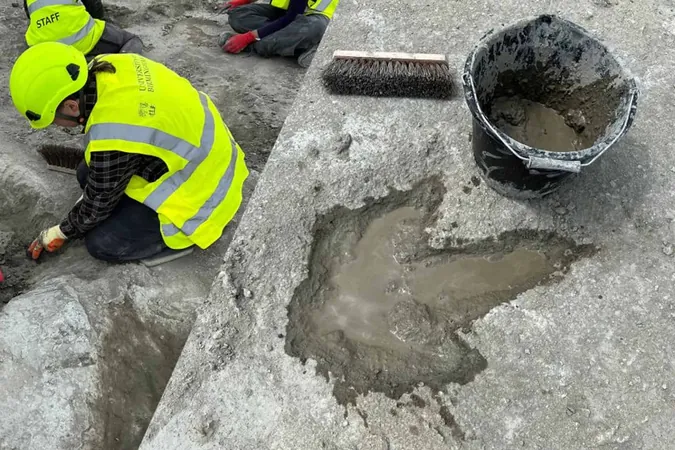
Shocking Discovery: Over 200 Jurassic-Era Dinosaur Footprints Found on UK’s Largest Dinosaur Highway!
2025-01-08
Author: Michael
Groundbreaking Excavation at Dewars Farm Quarry
In a groundbreaking excavation at Dewars Farm Quarry in Oxfordshire, England, researchers have unearthed a staggering 200 dinosaur footprints that date back to the Mid-Jurassic period, approximately 166 million years ago. This remarkable find is being hailed as the largest dinosaur trackway ever discovered in the UK, capturing the imagination of both scientists and dinosaur enthusiasts alike.
Remarkable Footprints of Cetiosaurus and Megalosaurus
Among the most impressive highlights from this site are footprints attributed to the massive 18-meter-long Cetiosaurus, a towering herbivore, and the nine-meter-long Megalosaurus, recognized as the first dinosaur to be scientifically named. Interestingly, the term “Megalosaurs” first appeared in literature back in 1824, predating the word “dinosaur,” which was coined in 1842.
Significance of the Discovery
Emma Nicholls, a key researcher and collection manager at the Museum of Natural History, emphasized the significance of this discovery. “Scientists have been studying megalosaurs for longer than any other dinosaur on Earth, yet these recent discoveries show that there’s still so much more to learn about these creatures,” she noted.
Discovery by a Quarry Worker
The journey to this extraordinary discovery began when quarry worker Gary Johnson was operating a digger. He noticed unusual humps in the clay, and upon clearing away the mud, prehistoric footprints emerged. “I felt like I was the first person to see them. It was surreal—a real tingling moment,” Johnson shared with the BBC.
Intense Excavation by Scientists
Following Johnson’s discovery, a team of over 100 scientists from the University of Oxford and the University of Birmingham descended upon the site for two weeks of intense excavation work. They uncovered five distinct dinosaur trackways, with the longest stretching an impressive 150 meters. Of the 200 footprints found, the tracks indicate that large, long-necked sauropods traversed four of them, while carnivorous megalosaurs walked along one track.
Rarity of the Footprints
“It’s incredibly rare to find such an abundance of footprints in one location, and even rarer to uncover extensive trackways like these,” explained Nicholls to AFP.
Media Spectacle and Documentation
The excavation was not only a scientific endeavor but also a media spectacle, as a BBC team documented the findings in a film titled "Digging for Britain," which premiered on January 7, 2023. During the dig, the researchers took over 20,000 photographs of the footprints and excavation site, with plans to create detailed 3D models that bring this ancient landscape back to life.
Insights from Dinosaur Footprints
Richard Butler, a prominent palaeobiologist involved in the project, highlighted that “dinosaur footprints offer a unique glimpse into the lives of these ancient creatures. They reveal how the dinosaurs moved and provide insights into the environment they inhabited—information that cannot be gleaned solely from bones.”
Preservation of the Footprints
Remarkably, the footprints indicate that the area was once a warm, muddy lagoon, which was later buried by sediment after a storm, perfectly preserving the trackways for millions of years. Without such preservation, those traces of prehistoric life could have easily been destroyed.
Dinosaur Interactions and Environment
Additionally, the researchers noted that the findings illustrate a moment where megalosaurs and sauropods intersected, allowing scientists to reconstruct interactions between these species and their environment. Duncan Murlock, another collections manager at the Museum of Natural History, stated, “The preservation is so detailed that we can observe how the mud deformed under the dinosaurs’ weights. Together with other fossils found, we can vividly recreate the lush lagoon milieu that the dinosaurs roamed.”
Future of the Discovery Site
As excitement builds around these significant discoveries, the next critical phase involves preserving the footprint site. Given the extensive area they cover, scientists are collaborating with quarry operators to establish effective protection measures to safeguard this monumental piece of our planet's prehistoric past.
Conclusion
Stay tuned for more astonishing discoveries from the Jurassic era—who knows what secrets the Earth is still hiding?



 Brasil (PT)
Brasil (PT)
 Canada (EN)
Canada (EN)
 Chile (ES)
Chile (ES)
 Česko (CS)
Česko (CS)
 대한민국 (KO)
대한민국 (KO)
 España (ES)
España (ES)
 France (FR)
France (FR)
 Hong Kong (EN)
Hong Kong (EN)
 Italia (IT)
Italia (IT)
 日本 (JA)
日本 (JA)
 Magyarország (HU)
Magyarország (HU)
 Norge (NO)
Norge (NO)
 Polska (PL)
Polska (PL)
 Schweiz (DE)
Schweiz (DE)
 Singapore (EN)
Singapore (EN)
 Sverige (SV)
Sverige (SV)
 Suomi (FI)
Suomi (FI)
 Türkiye (TR)
Türkiye (TR)
 الإمارات العربية المتحدة (AR)
الإمارات العربية المتحدة (AR)